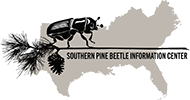Abstract
Local outbreak risk for the southern pine beetle, Dendroctonus frontalis Zimmermann (Coleoptera: Curculionidae), is forecast with a trapping survey conducted every spring throughout the southeastern United States. Traps baited with pine odors and components of the D. frontalis aggregation pheromone are used to obtain abundance estimates of both this species and its clerid predator Thanasimus dubius (F.) (Coleoptera: Cleridae); these data are entered into a predictive model that estimates outbreak risk. An attractant synergist for D. frontalis, endo-brevicomin, has recently been included in the survey lure, but it can have the unintended effect of attracting nontarget species Hylesinus pruinosus Eichhoff (Coleoptera: Curculionidae: Scolytinae) and Enoclerus nigripes (Say) (Coleoptera: Cleridae) which, due to their sometimes large numbers and general similarity in appearance to the target species, could complicate sorting and counting of trap catches. Analysis of bycatch data from a previously-published, 31-mo trapping study in Mississippi indicated that displacement of the endo-brevicomin releaser 6 m from the trap largely eliminated catches of the nontarget species H. pruinosus and E. nigripes while not reducing catches of the target species D. frontalis and T. dubius. Our analysis demonstrates that interspecific differences in spatial responses to attractive semiochemicals can be used to improve insect trap selectivity. Both nontarget beetle species were captured in highest numbers during late winter/early spring, coinciding with the D. frontalis survey.
Keywords
Hylesinus pruinosus, Enoclerus nigripes, Dendroctonus frontalis, Thanasimus dubius, bycatch
To read the full article please visit the link below:
Shepherd, William P., and Brian T. Sullivan. 2018. “Spatial Displacement of a Lure Component Can Reduce Catches of Two Nontarget Species During Spring Monitoring of Southern Pine Beetle.” Journal of Insect Science (Online) 18 (1). https://doi.org/10.1093/jisesa/iex106.
